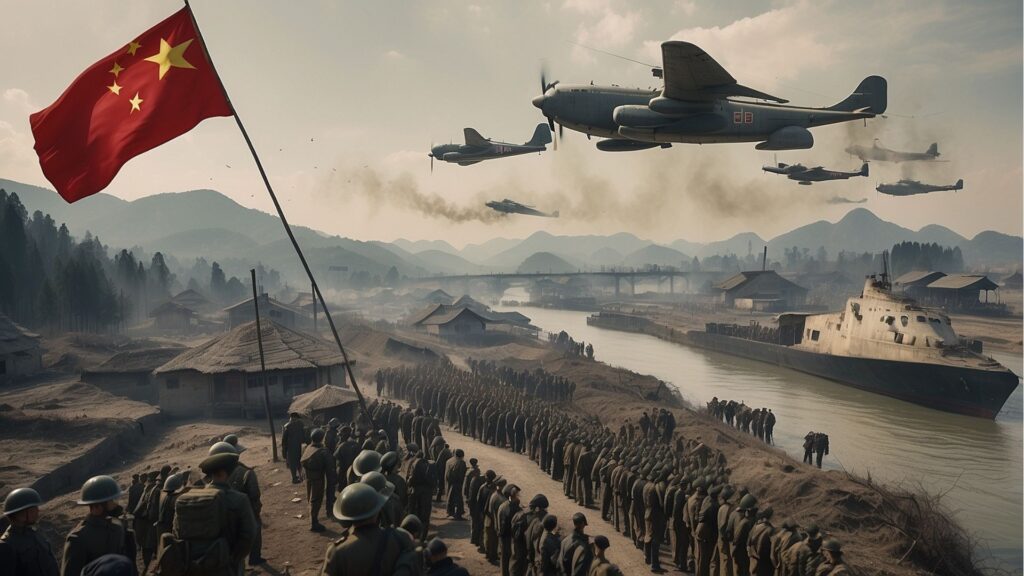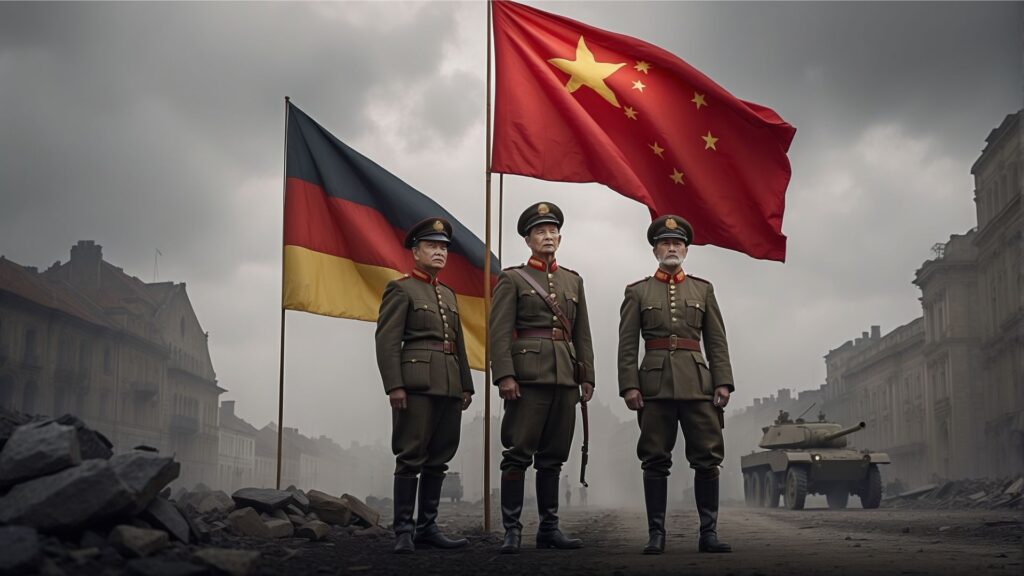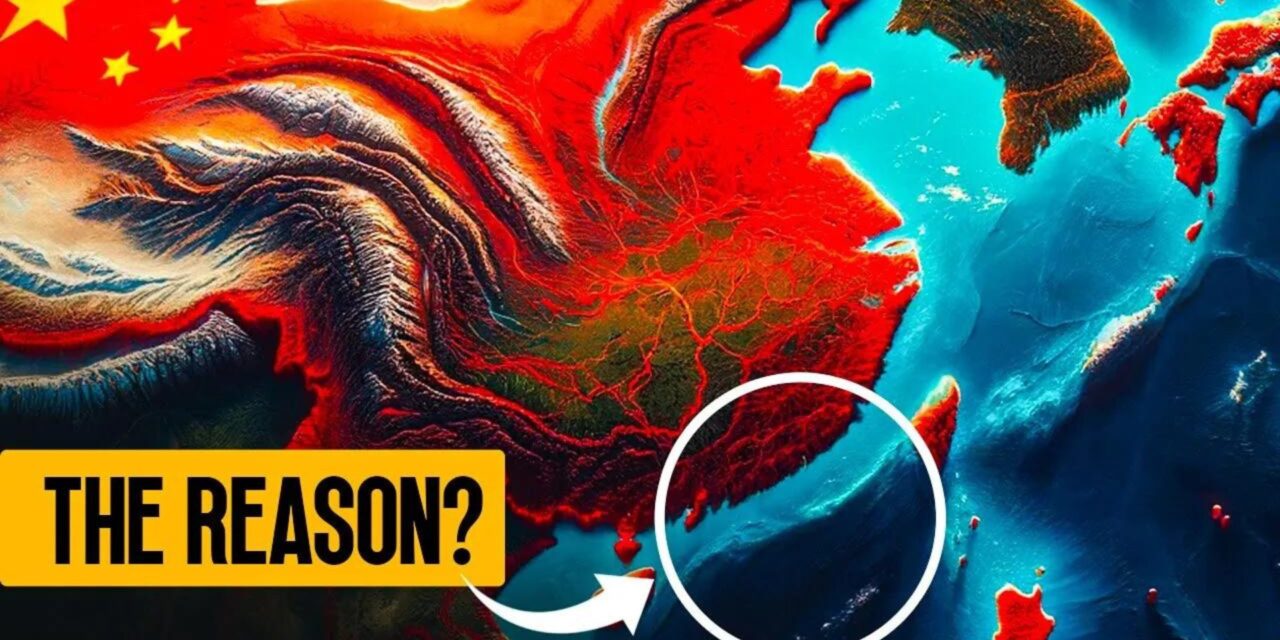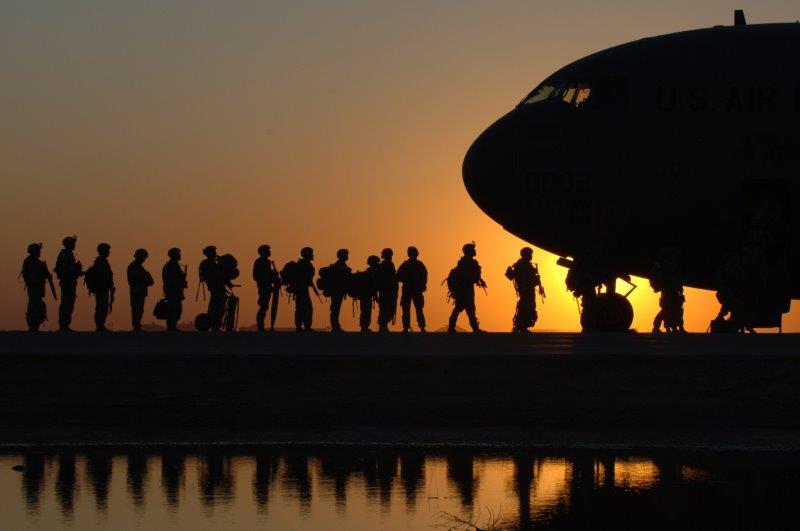Simmering tensions between China and other major powers have raised alarms in recent years as accelerated military buildups, aggressive actions over disputed territories, and hardening ideological contests between governance models all seem to indicate rising risks of a major military conflict with potential global implications.
With economic integration failing to dampen nationalism and security dilemmas inflaming historic disputes, Asia especially has emerged as an epicenter of gathering storms with multiple flashpoints ripe for miscalculation. Meanwhile advanced technologies shorten decision timelines across potential battlespaces spanning from cyberspace to outer space. Altogether an extremely volatile situation has emerged where even a minor spark could unleash uncontrolled escalations towards the brink of World War III.
So, when will WW3 start and is China the trigger? This article reviews the threats compounding risks of inadvertent conflict by focusing closely on China’s disruptive rise and aggressive actions aimed at asserting regional dominance potentially all the way towards attempted conquest over Taiwan.
Key Takeaways:
- Tensions are rising between China and other major powers, sparked by China's military buildup, aggressive actions, and ambitions for regional dominance
- China's territorial disputes, especially regarding Taiwan, could lead to military conflict and draw other countries into a wider war
- Historical precedents show how wars often start through escalating tensions and unintended consequences
- China's trajectory has alarming parallels to aggressive powers like Germany before previous world wars
- While WW3 is not inevitable, the risks of miscalculation and escalation pose a growing threat
China's dramatic rise over recent decades has shifted the global balance of power and raised tensions between China and other major countries. As China continues its military modernization efforts and asserts its territorial claims in the Asia-Pacific more forcefully, many experts warn of the growing potential for a major military conflict, or even another world war.
Rising Tensions Between China and Other World Powers
In recent years including 2023, relations between China and several other world powers have become increasingly strained. These tensions have centered around issues like trade disputes, technological rivalry, diplomatic spats, and growing mistrust between governments.

Most notably, a trade war erupted between China and the United States during the Trump presidency in 2018. Both countries continue imposing tariffs and restrictions on each other, despite an ostensible trade deal. Many observers see this economic rivalry as part of a broader contest for technological and military supremacy. These escalating tensions have sparked fears that a new Cold War is emerging between China and the U.S.-led Western bloc.
Beyond the U.S., China also has highly strained relations with regional powers like Japan, India, and Australia. Territorial and maritime disputes have aggravated historic rivalries with Japan and India. Meanwhile Australia has felt economic coercion from China in retaliation for Australia's call for an investigation into China's handling of COVID-19. These tensions reveal China's willingness to leverage its growing power against countries that oppose its interests.
"In key regions and leading sectors, Beijing has mobilized massive resources in support of ambitious industrial plans like Made in China 2025. China aims to become dominant by establishing sole or primary control over critical sectors, markets and supply chains." - 2021 Annual Threat Assessment, Office of the Director of National Intelligence
As China continues gaining economic, technological and military strength while aggressively asserting its interests, surrounding countries increasingly view China's rise as a threat. These dynamics are creating a classic security dilemma, where actions taken by one power to increase its security are perceived as threatening by others, fueling greater tensions and mistrust. If this predicament of hostility and suspicion between rival powers spirals out of control, it could ultimately lead the world towards another global conflict.
China's Territorial Disputes with Neighboring Countries
A major flashpoint raising the risk of a military clash is China's unresolved territorial disputes with neighboring countries. China claims expansive territorial and maritime boundaries, based largely on ambiguous historical claims. These assertive claims frequently conflict with other Asian countries' sovereignty and borders.
Disputed areas include resource-rich waters in the South China Sea and East China Sea, border regions like Arunachal Pradesh on the China-India border, and the Senkaku/Diaoyu Islands controlled by Japan but claimed by China. To bolster its claims, China has undertaken massive reclamation projects building artificial islands and military bases across the South China Sea. These disputed zones have become highly militarized powder kegs, with frequent maritime standoffs and military posturing.
The Taiwan Issue and Potential for Military Clash
However, the most dangerous flashpoint by far is Taiwan. China views Taiwan as an integral part of its territory awaiting reunification, by force if necessary. Meanwhile Taiwan sees itself as de facto independent, although its official status remains ambiguous. This enduring dispute frequently erupts into military brinkmanship and raises the danger of escalation into armed conflict, which could quickly engulf other global powers like the U.S.
On an accelerating basis, China has deployed fighter jets, bombers and warships for menacing military drills around Taiwan. These exercises simulate invasions and serve to intimidate Taiwan while gauging future military options. Additionally, China exerts economic coercion against Taiwan and blocks its participation in most international organizations. Although the prospect of attempting to forcibly conquer Taiwan remains highly risky for China, President Xi Jinping has indicated resolving "the Taiwan question" is a core interest he aims to advance.
Did You Know: In October 2021, a record 149 Chinese military aircraft crossed into Taiwan's air defense zone over just a few days, highlighting the increasing military pressure Beijing applies through shows of force near Taiwan.
As China intensifies military pressure on Taiwan, it risks triggering heightened responses by the U.S., Japan and others. This island democracy serves as a crucial hub enabling Western military dominance in the region. Any armed attack that threatened Taiwan's independence could readily spiral into a wider conflagration between great powers. With nationalist sentiments and prestige on the line for both China and Taiwan's allies, navigating this dispute peacefully presents an ongoing near-term hazard.
“Once begun, warning systems, diplomacy, and distance can only mitigate war's terrible effects. The best outcome requires prevention. Leaders must understand their enemies, give diplomacy its rightful voice, and never lose sight of war's immutable nature” - Historian Margaret MacMillan
U.S.-China Rivalry Over Influence in Asia and Beyond
Beyond the Taiwan flashpoint, rivalry and mistrust between China and the U.S. poses broad risks as these two ascending superpowers compete for power and influence across Asia and around the world. Other countries could get caught in the middle of this intensifying great power competition.
From the South China Sea to the Indian Ocean to the Arctic, China and the U.S. perceive themselves to be locked in a high stakes struggle for military advantage and control over strategic waterways. As China modernizes its navy into a blue-water force and establishes overseas bases along vital shipping routes, many analysts foresee increasing jostling and confrontation between Chinese and American vessels. These frictions could precipitate an unintended conflict, or prompt preemptive military action stemming from threat perceptions by either side during a crisis.
Moreover, U.S.-China sparring now extends to all facets of national power like trade, technology, geopolitics and international institutions. This multidimensional rivalry spans economic coercion, 5G network competition, semiconductor export controls, ideological contests over governance models, vaccine diplomacy for geopolitical influence, and much more. As the scope of U.S.-China antagonism broadens, these intersecting tensions amplify the risks of conflict even from relatively peripheral disputes. Without concerted crisis management mechanisms and overarching guardrails to manage bilateral relations, simmering economic and diplomatic disputes could boil over into the military sphere as well.
China's Military Buildup and Provocative Actions
Alongside China's rise and these growing external tensions, China has massively expanded its military capabilities in recent decades. While China insists its military modernization serves purely defensive aims, surrounding countries increasingly view China's buildup as threatening. China's lack of transparency around the scale and purposes of its armaments adds to regional instability and distrust.

China's Investments to Modernize its Military Capabilities
Fueled by two decades of rapid economic growth, China has undertaken the largest military buildup seen in Asia since Japan's before WWII. China's officially disclosed defense budget has grown over 25 times from $17B in 1997 to $1.45 trillion in 2022. Although China's spending remains below America's military budget, China focuses its investments specifically on areas enabling anti-access and area denial warfare against the U.S. Navy in Asia.
Key buildup areas include ballistic and cruise missiles, integrated air defense systems, anti-ship missiles, fighter aircraft, electronic and cyber warfare capabilities, and more. China aims to wield "world class" military forces by 2049 able to fight and win regional wars under "informatized" conditions. If realized, these ambitions could upend the strategic military balance underpinning stability across Asia.
| Military Capability | Current Status |
|---|---|
| Land forces personnel | Largest standing ground force globally with 975,000 active duty personnel |
| Navy fleet size | 360+ ships and submarines including 140+ major surface combatants, surpassing the U.S. Navy's 297 ship fleet |
| Fighter aircraft | Among top air forces globally with 1,800+ fighters, bombers and attack aircraft |
| Missiles and launchers | World's largest arsenal with over 1,900 short-range and mid-range ballistic and cruise missiles and advanced mobile launchers |
| Nuclear warheads | Rapid modernization underway, estimated inventory of 400+ warheads with further expansion planned |
Additionally, China leads in emerging technologies like hypersonics, electromagnetic railguns, autonomous drones, AI-enabled warfare, and more that could provide asymmetric advantages. By leveraging strengths in areas like missiles, asymmetric systems and layered defense networks, China aims to establish military superiority within the First Island Chain along its periphery and expand its global power projection capabilities.
Increased Chinese Military Drills and Exercises
Alongside hardware improvements, China has significantly increased its military drills and exercises. These operational activities help the People's Liberation Army (PLA) simulate wartime missions, validate new capabilities, and signal military prowess in areas like amphibious landings and long-range bombing training increasingly aimed at Taiwan.
In 2022, the PLA conducted exercises along all of China's regional flashpoints, including Taiwan, the South China Sea, and disputed land borders with India and Bhutan. These unprecedented operations in scope, scale and provocative messaging have alarmed China's neighbors. If unchecked, China's military activities could enable it to unilaterally change the status quo in places like Taiwan, the East China Sea or across India's vulnerable border region.
China's Development of Advanced Weapons and Technologies
At the same time, China is charging ahead developing numerous advanced and destabilizing weapons technologies. Areas of asymmetry like cyber, anti-satellite, EMP, and AI-enabled information warfare could provide China means to undermine adversaries in alarming ways during any conflict. China has already demonstrated potent cyber capabilities through intellectual property theft and hacks against governments along with tests destroying satellites in space.
Meanwhile China aims to rapidly expand its nuclear forces in both numbers and capabilities like incorporated stealth, mobility, penetration aids and evasion. China's opacity around its nuclear modernization plans raises deep concerns over a regional arms race amid eroding strategic stability. Additionally, China fields growing numbers of capable conventional ballistic missiles like DF-26 “Guam Killer” missiles able to strike U.S. bases, ships and aircraft. These precise conventional missiles provide non-nuclear means for precision strikes worldwide.
Overall, the breadth, focus and secrecy of China's military modernization signal ambitions for an expeditionary force with capabilities rivaling and deterring current U.S. military superiority. These disruptive advances could critically undermine regional strategic balances of power. As China's military capabilities catch up with its strategic ambitions, the risks of Chinese attempts to forcibly settle simmering disputes only grow.
How China Could Spark a Global Conflict
In several plausible pathways, China's actions aimed at advancing its interests could set off cascading events ultimately leading to another world war. While any conflict scenarios remain highly uncertain, China seems increasingly willing to take risks and assert its power amid perceptions the global balance of forces is shifting in its favor.

Scenarios Where China Initiates Military Action
In an attempt to consolidate territorial control or during times of domestic instability when propaganda victories hold appeal, China could initiate direct military action in places like Taiwan, the South or East China Seas or along land borders.
While still unlikely in the near-term given the major risks, President Xi Jinping has indicated settling territorial disputes represents a core Chinese interest. Provocations or domestic pressures could prompt Beijing to take reckless action it might otherwise avoid. Over China's National Day in early October 2022, Chinese netizens flooded social media demanding military action on Taiwan after an all-time record 149 People's Liberation Army warplanes crossed into Taiwan’s airspace over just a few days. This nationalistic online outrage highlights wider public support for military action. As such fury grows, Beijing could feel compelled to divert tensions outwards rather than face blame for allowing domestic problems to fester.
Any Chinese aggression would assuredly spark international backlash and sanctions or even counter-interventions. For example, a Chinese play for Taiwan or blockade attempts could trigger American and Japanese forces stepping in to reinforce Taiwanese defenses. From there, rapid tit-for-tat military escalations could spiral into an unpredictable and unconstrained war.
Responses and Counteractions That Could Lead to WW3
While China initiating armed conflict represents perhaps the most direct path to catastrophe, responses and counteractions by regional military powers like the U.S., India or Japan could also spark wider conflagrations. As military tensions rise, any direct attack against China or Chinese forces during a confrontation or crisis could prompt an overwhelming response and rapid escalation towards war.
Did You Know: China's defense budget has grown over 25 times from $17 billion in 1997 to $1.45 trillion in 2022 as the country massively expands its military capabilities.
If India responded with massive retaliation to future border incursions, if Japan elected to actively deny Chinese access around the Senkaku Islands, or if the U.S. chose to intervene against Chinese adventurism towards Taiwan with direct attacks, China could reply with overwhelming force. Rapid cycles of action and reaction could intensify confrontations into full-blown wars given national prestige and resolve facing severe tests along with domestic pressures demanding firm stances against perceived aggression.
With nuclear-armed rivals like China, India, and the U.S. directly in opposition, space for restrained de-escalation could rapidly evaporate amid calls for decisive military victory from bellicose publics and governments. Without clear communications or guardrails to manage brinkmanship during crises, the current dynamics point disturbingly towards eventual miscalculation if not outright catastrophe. Altogether, many potential conflict triggers between China and regional military powers exist. Any direct attack or intervention against Chinese forces could start civilization down a slippery slope towards disaster given all sides now actively prepare for war in Asia.
Assessing the Risks of Miscalculation and Unintended Escalation
Perhaps the most menacing danger is unintended escalation from lower-level disputes or military standoffs into outright combat operations and war. Well-established precedents show how seemingly minor flashpoints like the assassination of Austria’s Archduke Ferdinand in 1914 can unleash continent wide conflagrations due to inflexible military mobilization timetables and tangled alliances drawing multiple great powers into war. In today’s context, immature crisis management mechanisms raise real dangers that a collision at sea, border skirmish or hybrid attacks could rapidly spiral towards uncontrolled conflict.
With rising military deployments across Asia and crises prone to emerge with little warning, space exists for accidental strikes or aggression rooted more in threat perceptions than reality. During tense standoffs like around Taiwan, both sides now prime forces constantly on hair-trigger alert, dramatically shortening decision-making timelines while increasing chances of mistakes under pressure. Meanwhile advanced technologies add to volatility from vulnerability to surprise attacks, dual-use conventional weapons enabling rapid escalation and AI-enabled speed-of-light decision loops prone to initiating combat based on limited information.
Altogether, the risks of rapid, uncontrolled military escalation through some combination of miscalculation, misperception and miscommunication have risen substantially. As military brinkmanship between nuclear powers intensifies across the region, leaders will walk an increasingly fine line to avoid stumbling into conflict through simple blunders or arrogantly assuming they control events once violence erupts and passions inflame. With ever greater forces deployed on maneuvers in contested areas, the margin for error has become disturbingly slim.
Historical Precedents and Parallels with China
Many parallels and precedents from early 20th century history offer alarming lessons on how major wars often erupt unexpectedly from relatively small initial conflicts that rapidly engulf surrounding powers. As tensions rise in Asia today, leaders seem to forget history’s harsh lessons, instead stumbling towards familiar cycles of military brinkmanship and mutually reinforcing hostility.

Drawing Lessons from the Outbreak of Past World Wars
In particular, cascading miscalculations and entangling alliances helpful initially for deterrence ultimately triggered catastrophic great power wars in both WWI and WWII. Aggressors like Kaiser Willhelm II and Adolf Hitler repeatedly misjudged adversaries’ willingness to back down in the face of menacing threats and faits accomplis. Meanwhile countries like the U.K and France provided their marginal allies confident security pledges assuming this support would prevent rather than trigger war. Tragically of course, this mutual misunderstanding of intentions coupled with military mobilization rigidities ultimately made war nearly inevitable once any conflict sparked in this tinderbox environment.
Today in Asia similar dynamics see all sides constantly testing resolve through shows of force and acts of intimidation met by displays of defiance. With security guarantees underpinning nearly all regional flashpoints, any act of aggression could readily draw major powers into war as Taiwan, Japan, India and others refuse to be cowed by Chinese brinkmanship while relying on American deterrence. Meanwhile recurring crises reveal poor communications between rivals and overconfidence in untested capabilities meant to deter war. Altogether an extremely unstable and hazardous situation exists where any misjudged act of boldness could unleash uncontrollable events.
China's Rise Mirroring Germany's Prior to WW1 and WW2
Furthermore, the historical trajectory of China’s rise represents in some ways an eerie echo of Germany before both world wars. In each case, a newly unified nation-state rapidly industrialized to become an economic and military behemoth at the heart of Europe/Eurasia. Meanwhile, growth in power and prestige fostered matching senses of national ambition and perceived entitlement to expanded spheres of influence, colonial holdings and foremost power status. However established imperial powers hoped to constrain these disruptive interlopers through diplomatic exclusion and military containment.
Did You Know: In 2021, China tested a record breaking hypersonic missile that circled the globe before striking a target, demonstrating capabilities to evade American missile defenses.
This structural imbalance bred resentment and zero-sum hostility on all sides. While clearly oversimplified, certain parallels exist in China’s indignation at historic mistreatment, its humiliation after unequal treaties and foreign spheres of influence stripped away sovereign control, and its current resentment towards perceived containment by America’s system of regional allies and military dominance in Asia. These past humiliations shape China’s strategic culture and national ambitions today.
Like Germany in 1914, China also increasingly believes ongoing shifts in relative power allow opportunities to advance core strategic interests and regain lost territories or status before time runs out. This sentiment likely accelerates Chinese risk tolerance and willingness to exercise raw power as the country views itself surrounded by suspicious rivals committed to blocking its rightful rise. Without creative diplomacy, these structural tensions seem prone to eventual catastrophic blowups as established lead hegemons fight to constrain rising aspirants through shows of force, exclusion and containment while the rising power probes continually for weakness and tests its strength through intimidation downhill towards conflict.
Ideological Drivers and Goals Underpinning Chinese Aggression
Finally, assessing WW3 risks requires examining the ideological underpinnings of China’s envisioned world order and whether Beijing sees war as inevitable or necessary to achieve its vision of national rejuvenation premised on eradicating perceived past humiliations. Some degree of conflict may seem both unavoidable and required in Beijing's thinking given China's conviction that established powers led by the U.S. remain utterly committed to perpetuating unjust obstacles preventing China's restoration as the dominant civilization occupying central position in Asia and indeed the world across coming decades.
With such a sweeping transformation envisioned, China's leadership likely assesses major changes to the global order cannot occur without turbulence if not outright struggle against stubborn resistance by declining incumbent powers refusing to accommodate China's destined resurgence.
Did You Know: In 2007, China successfully tested an anti-satellite missile to destroy one of its own aging weather satellites at an altitude of 500 miles in space.
Some analysts assess that China's ruling Communist Party views ongoing ideological struggle between authoritarian and democratic systems as both inevitable and existential. In Chinese strategic thinking, gaining decisive strategic advantage requires seizing key windows of opportunity opened by perceived shifts in correlations of forces. From Beijing's perspective, timelines for settling core territorial claims and expanding global influence keep shortening amid fears of "containment" by adversaries. Therefore, China likely feels increasing pressure to act boldly in places like Taiwan sooner rather than later.
Additionally, President Xi and other leaders evoke historic national rejuvenation narratives implying restoration of perceived past glory. These ideological imperatives seeking to overcome "century of humiliation" subjugation at foreigners' hands inform policymaking in ways that could lower restraint against use of force. With Communism's political legitimacy tied closely to sustaining economic expansion and stoking nationalism, Beijing may turn to military adventurism more willingly during times of domestic trouble. Altogether, ideological drivers and goals underpinning Chinese aggression exist on multiple levels from immediate distraction imperatives during instability to deeper beliefs war is necessary to defeat Western-led "hegemonism" and realize China's destined primacy.
Conclusion on Why China May Start the Third World War
While the path towards potential World War 3 remains filled with uncertainties, challenging trends are colliding to test Asia's uneasy 21st century stability with alarming frequency. As unmatched military firepower concentrates across Indo-Pacific hotspots ripe for miscalculation, all countries face escalating pressures including economic distress, nationalist fervor, and fear of aggression or lost prestige that history shows can drive explosive cycles of brinkmanship.
With Communication unreliable between rivals, crisis management capacity untested, and leaders facing unrelenting domestic calls for resolve, the risks of governments stumbling blindly into catastrophe through reflexive displays of strength steadily mount. Given Asia’s deep interconnectedness, any spark would likely engulf surrounding powers and alliance blocs spanning the Pacific and Eurasia in no time. Therefore leaders worldwide must work urgently to disentangle military deployments near flashpoints, strengthen crisis communication mechanisms and develop common rules of engagement to prevent minor conflicts from unleashing this century’s next great unraveling – a war nobody wins.
FAQ
Could the war in Ukraine lead to World War III?
While Russia's invasion of Ukraine has led to Europe's largest ground war since 1945, most experts believe the conflict is unlikely to directly spread into a full-blown World War III scenario drawing in NATO countries and Russia. However, if Russia were to attack NATO member states like Poland after occupying parts of Ukraine, that could potentially trigger a much larger war.
What could realistically prevent World War III?
Avoiding provocative actions that could spark uncontrolled escalations is the key to preventing World War III. Diplomatic solutions ending conflicts like Russia's invasion of Ukraine combined with all powers exercising military restraint and avoiding direct attacks against rivals would reduce risks substantially. Stronger crisis communication mechanisms and guardrails managing tensions could also help.
Is it possible to predict the start of World War III?
Given the uncertainties inherent in international relations along with the complex dynamics between multiple nuclear powers that could produce rapid unintended escalations, it remains impossible to reliably predict the precise start of any theoretical World War III. While tensions clearly are rising between rivals, too many wildcard factors exist to forecast the exact spark leading to such a globalized conflict.
Could the Israel-Hamas conflict trigger WWIII?
While clashes between Israel and Hamas occasionally flare up, these remain localized conflicts focused on issues mainly related to Gaza and statehood. Broader military interventions by other Middle East powers are unlikely absent Israeli attacks on another country. As such it seems unrealistic escalations of Israeli-Palestinian tensions could single-handedly draw major world powers directly into conflict.
How has Russia’s invasion of Ukraine impacted WWIII risks?
By further straining West-Russia relations, hardening hostility between rival blocs, showcasing NATO’s solidarity with allies, and demonstrating both sides’ willingness to absorb substantial costs rather than show weakness, events in Ukraine have exacerbated global tensions in several respects. This deterioration of relations and stability modestly raises WWIII risks but hasn't fundamentally transformed global conflict probabilities yet.
Could China's support for Russia lead towards WWIII? While deepening China-Russia alignment does raise concerns of emboldening more revisionist policies from both countries, China still remains unlikely to directly intervene militarily in Ukraine. Were China to join in combat operations alongside Russia, risks of escalatory cycles with NATO would rise substantially. Still, beyond diplomatic and economic backing, China appears reluctant to enter any actual fighting for now.
What are experts most worried about regarding risks of WWIII?
Experts express greatest unease around unattended regional flashpoints like Taiwan, the South China Sea, India-Pakistan border disputes and others where relatively minor clashes could swiftly engulf surrounding powers and alliance blocs. With global rivals operating in close proximity across Asia especially, dangers persist for accidental battles amid poor communication leading towards tit-for-tat spirals into broader conflict. Crisis management weaknesses multiplying risks during any major provocation likely keep experts awake most regarding WWIII dangers.











